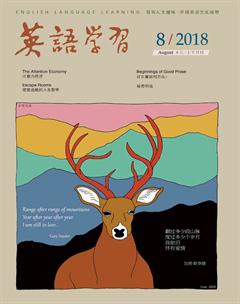注意力经济
By Tom Chatfield

How many other things are you doing right now while youre reading this piece? Are you also checking your email, glancing at your Twitter feed, and updating your Facebook page? What five years ago David Foster Wallace labelled “Total Noise”— “the seething static of every particular thing and experience, and ones total freedom of infinite choice about what to choose to attend to”1—is today just part of the texture of living on a planet that will, by next year, boast one mobile phone for each of its seven billion inhabitants. We are all amateur attention economists, hoarding and bartering our moments2—or watching them slip away down the cracks of a thousand YouTube clips.
If youre using a free online service, the adage3 goes, you are the product. Its an arresting4 line, but one that deserves putting more precisely: its not you, but your behavioural data and the quantifiable facts of your engagement that are constantly blended for sale, with the aggregate of every single interaction (yours included) becoming a mechanism for ever-more-finely tuning the business of attracting and retaining users.
Consider the confessional slide show released in December 2012 by Upworthy, the “website for viral content”, which detailed the mechanics of its online attention-seeking. To be truly viral, they note, content needs to make people want to click on it and share it with others who will also click and share. This means selecting stuff with instant appeal—and then precisely calibrating5 the summary text, headline, excerpt, image and tweet that will spread it. This in turn means producing at least 25 different versions of your material, testing the best ones, and being prepared to constantly tweak6 every aspect of your site. To play the odds, you also need to publish content constantly,in quantity, to maximise the likelihood of a hit—while keeping one eye glued to Facebook. Thats how Upworthy got its most viral hit ever, under the headline “Bully Calls News Anchor Fat, News Anchor Destroys Him on Live TV”, with more than 800,000 Facebook likes and 11 million views on YouTube.

But even Upworthys efforts pale into insignificance compared with the algorithmic might of sites such as Yahoo!—which, according to the American author and marketer Ryan Holiday, tests more than 45,000 combinations of headlines and images every five minutes on its home page. Much as corporations incrementally improve the taste, texture and sheer enticement of food and drink by measuring how hard it is to stop eating and drinking them, the actions of every individual online are fed back into measures where more inexorably means better: more readers, more viewers, more exposure, more influence, more ads, more opportunities to unfurl the integrated apparatus of gathering and selling data.7
Attention, thus conceived, is an inert and finite resource, like oil or gold: a tradable asset that the wise manipulator auctions off to the highest bidder, or speculates upon to lucrative effect.8 There has even been talk of the world reaching “peak attention”, by analogy to peak oil production, meaning the moment at which there is no more spare attention left to spend.
This is one way of conceiving of our time. But its also a quantification that tramples across other, qualitative questions—a fact that the American author Michael H Goldhaber recognised some years ago, in a piece for Wired magazine called “Attention Shoppers!” (1997). Attention, he argued, “comes in many forms: love, recognition, heeding, obedience, thoughtfulness9, caring, praising, watching over, attending to ones desires, aiding, advising, critical appraisal, assistance in developing new skills, et cetera. An army sergeant ordering troops doesnt want the kind of attention Madonna seeks. And neither desires the sort I do as I write this.”
For all the sophistication of a world in which most of our waking hours are spent consuming or interacting with media, we have scarcely advanced in our understanding of what attention means. What are we actually talking about when we base both business and mental models on a “resource” that, to all intents and purposes, is fabricated from scratch every time a new way of measuring it comes along?
In Latin, the verb attendere—from which our word“attention” derives—literally means to stretch towards. A compound of ad (“towards”) and tendere (“to stretch”), it invokes an archetypal10 image: one person bending towards another in order to attend to them, both physically and mentally.
Attending is closely connected to anticipation. Soldiers snap to attention to signify readiness and respect—and to embody it. Unable to read each others minds, we demand outward shows of mental engagement. Teachers shout “Pay attention!”at slumped11 students whose thoughts have meandered, calling them back to the place theyre in. Time, presence and physical attentiveness are our most basic proxies12 for something ultimately unprovable: that we are understood.
The best teachers, one hopes, dont shout at their students—because they are skilled at wooing13 as well as demanding the best efforts of others. For the ancient Greeks and Romans, this wooing was a sufficiently fine art in itself to be the central focus of education. As the manual on classical rhetoric Rhetoricaad Herennium put it 2,100 years ago: “We wish to have our hearer receptive, welldisposed, and attentive (docilem, benivolum, attentum).” To be civilised was to speak persuasively about the things that mattered: law and custom, loyalty and justice.
Underpinning this was neither honour nor idealism, but pragmatism embodied in a five-part process. Come up with a compelling proposition, arrange its elements in elegant sequence, polish your style, commit the result to memory or media, then pitch14 your delivery for maximum impact. Short of an ancient “share” button, the similarities to Upworthys recipe for going viral are impressive. Cicero15, to whom Rhetoricaad Herennium is traditionally attributed, also counted flattery, bribery, favour-bargaining and outright untruth among the tools of his trade. What mattered was results.
However, when it comes to automated systems for garnering attention, theres more at play than one person listening to another; and the processes of measurement and persuasion have some uncannily16 totalising tendencies. As far as getting the world to pay attention to me online, either I play by the rules of the system—likes, links, comments, clicks, shares, retweets—or I become ineligible17 for any of its glittering prizes.
Theres a similarly reductive exaltation in defining attention as the contents of a global reservoir, slopping interchangeably between the brains of every human being alive.18 Where is the space, here, for the idea of attention as a mutual construction more akin to empathy than budgetary expenditure—or for those unregistered moments in which we attend to ourselves, to the space around us, or to nothing at all?
We watch a 30-second ad in exchange for a video; we solicit a friends endorsement19; we freely pour sentence after sentence, hour after hour, into status updates and stock responses. None of this depletes our bank balances. Yet its cumulative cost, while hard to quantify, affects many of those things we hope to put at the heart of a happy life: rich relationships, rewarding leisure, meaningful work, peace of mind.
What kind of attention do we deserve from those around us, or owe to them in return? What kind of attention do we ourselves deserve, or need, if we are to be “us” in the fullest possible sense? These arent questions that even the most finely tuned popularity contest can resolve. Yet, if contentment and a sense of control are partial measures of success, many of us are selling ourselves far too cheap.
Are you still paying attention? I can look for signs, but in the end I cant control what you think or do. And this must be the beginning of any sensible discussion. No matter who or what tells you otherwise, you have the perfect right to ignore me—and to decide for yourself what waits in each waking moment.

你在阅读这篇文章的同时还在进行多少件其他的事情?你是否也在查看你的电子邮件,浏览你的Twitter信息,更新你的Facebook页面?五年前,戴维·福斯特·华莱士所说的“全面的噪音”——“每一件事物、每一个经历所带来的无处不在的滋滋噪音,以及人们对于究竟关注什么拥有无限选择的全面自由”——如今只是在这个星球上生活的一部分。到明年,这个星球的70亿居民每个人都将拥有一部手机。我们都是业余的注意力经济学家,囤积和交换我们的时时刻刻——或者看着它们在一千个YouTube视频的裂缝中溜走。
常言道,如果你在使用免费的线上服务,那么你就是产品。这是句很吸引人的话,但这句话还可以说得更准确一些:你并不是产品,产品是你的行为数据和你的行为中可量化的事实,它们不断被处理整合等待出售。每一次互动(包括你的在内)的总和成为一种通过更加精细的调整来吸引与留住用户的机制。
考虑一下“病毒式传播内容网站”Upworthy于2012年12月发布的自白幻灯片展示,该展示详细介绍了其吸引网上注意力的机制。幻灯片指出,要真正做到病毒式传播,内容需要让人们愿意点击并与他人分享,而这些人也会继续点击、分享。这意味着选择具有即时吸引力的内容——然后精确地校准出将会有助于传播的摘要文本、标题、节选、图像和推文。这意味着要将你的素材做出至少25种不同的版本,测试出最好的,并准备不断调整网站的各个方面。为了加大胜算,你还需要不断发布大量内容,以最大限度地提高点击率——同时也要盯着Facebook。这就是Upworthy如何做出史上传播最广的,即标题为“恶霸骂新闻主播胖,新闻主播在电视直播时灭了他”的内容。该条内容有超过80万个Facebook“赞”和1,100万的YouTube播放量。
但Upworthy的努力,与Yahoo!等网站的算法威力相比,就显得微不足道了。根据美国作家、营销人瑞安·霍利戴的说法,Yahoo!在主页上每五分钟测试超过4.5万个标题和图像的组合。就像企业通过测量人们停止进食某种食物和饮用某种饮料的难度来逐渐改善食物和饮料的味道、质地与吸引力那样,每个在线用户的行为都会被反馈到“更多”总是意味着“更好”的测评中:更多读者、更多观众、更多曝光度、更多影响力、更多广告、更多机会来展现收集和销售数据的综合机制。
注意力,如果从这个角度看,是一种惰性的、有限的资源,就像石油或黄金一样:这是一种可以交易的资产,机敏的操纵者将其卖给出价最高的竞价者,或者被用来投机倒把大赚一笔。通过类比石油峰值产量,甚至有人说世界达到“注意力峰值”,指的是没有更多多余的注意力可分的时刻。
这是理解我们时代的一种方式。但这也是一个踏着其他质性问题的量性问题——这是美国作家迈克尔·H. 戈德哈伯几年前就认识到的一个事实,发表在《连线》杂志一篇名为《注意力购物者!》(1997)的文章中。他认为,注意力“有多种形式:爱、认可、聆听、顺从、沉思、关爱、赞美、注视、关注某人的欲望、帮助、建议、批判性评估、协助开发新技能等等。一位给军队发号施令的军士并不需要麦当娜所追求的那种注意力。而我在写这些文字时也不需要这种注意力。”
尽管在这个复杂的世界,我们大多数醒着的时间都花在消费媒体或是与媒体互动上,但对于“什么是注意力”的理解我们几乎没有进步。当我们将商业和心理模型都建立在一种每次只要有新的衡量方式出现就要从头开始制造的“资源”基础上时,我们实际上是在谈论什么?
在拉丁语中,动词attendere——“attention”一词来源于此——从字面上来说意思是向前伸展。作为ad(“朝”)和tendere(“伸展”)的合成,这个词唤起了一个原始的画面:一个人为了在身体和精神上注意到另一个人,彼此都弯向对方。
注意与预期密切相关。士兵立正表示做好准备与尊重——并将其体现出来。由于无法阅读彼此的思想,我们需要精神活动的外在表现。老师对那些瘫坐着的神游到九霄云外的学生大喊“注意”,让他们回到他们所在的地方。时间、在场和身体上的注意是我们对某件最终无法证明的事情的最基本的替代:这件事就是我们被理解了。
人们希望,最好的老师不会对学生大吼大叫——因为他们擅长说服他人并要求他人做出最大的努力。对于古希腊人和罗马人来说,这种激励本身就是一种足够好的艺术,足以成为教育的核心焦点。正如古典修辞学手册《修辞学:献给赫伦尼厄斯》在2,100年前所说的那样:“我们希望能够让听者虚心接受、心怀友善和保持注意(docilem, benivolum, attentum)。”所谓教养就是要能令人信服地谈论重要的事情:法律与习俗、忠诚与正义。
支撑这一点的既不是荣誉也不是理想主义,而是体现在五个步骤的实用主义。提出一个令人信服的论点,按优雅的顺序排列其中的元素,给风格润色,将成品记在脑子里或是媒体上,然后大声传播出去以获得最大的影响力。除了古代沒有“分享”按钮,这与Upworthy的病毒式传播方法十分相似。一般认为《修辞学:献给赫伦尼厄斯》是由西塞罗所著,西塞罗也将奉承、贿赂、讨价还价和彻头彻尾的谎言作为他修辞学的工具。重要的是结果。
但是,就吸引注意力的自动系统而言,则不仅仅是一个人听另一个人说话,而衡量和说服的过程有一些难以解释的趋同趋势。如果要让全世界在网上关注我,我要么遵守系统规则——点赞、链接、评论、点击、分享、转发——要么就没有资格获得任何闪闪发光的奖品。
把注意力定义为一个全球水库中的内容,在每个活着的人的大脑之间可以倒来倒去,也是一样的简单粗暴。在这个定义中,有没有位置留给把注意力当做一种更类似于共情而非预算支出的由双方互相构建的想法?——或者留给那些我们关注自己,关注周围的空间,或者什么都不关注的“下线”时刻?
我们以观看30秒的广告作为代价才能看到视频;我们渴求朋友的点赞;我们毫无顾虑地将一个句子接一个句子、一个小时接一个小时倒进状态更新和毫无新意的回复中。以上任何一件事情都不会耗尽我们的银行账户。然而,其积累起来的成本,虽然难以量化,却会影响到许多对于幸福生活所必需的核心事情:丰富的人际关系、有益的闲暇、有意义的工作、心灵的宁静。
我们应该从周围的人那里得到什么样的注意力,又或是欠他们什么样的注意力呢?如果我们要成为真正意义上的“我们”,我们自己应该得到什么样的注意力,或者需要什么样的注意力?这些问题即使是经过最精细的调整的人气比赛也不能解决。然而,如果满足感和控制感是成功的部分衡量标准,那么我们中的很多人都以太低廉的价格把自己卖了。
你还在付出注意力吗?我可以找寻迹象,但最终我无法控制你的想法或者行为。这必须是任何理智的讨论的开始。无论是谁或者什么告诉你不同的意见,你完全有权忽视我——自行决定自己在每个醒着的时刻要干什么。
1. David Foster Wallace: 戴维·福斯特·华莱士(1962—2008),美国小说家,著有《无尽的玩笑》等作品。他在文学上极富造诣。内容上,他一直以巨大的好奇心关注这个物质的世界,以及生活在这个世界的人们的感受,尤其是那些生活在20世纪末的美国人;形式上,与20世纪80年代流行的简约主义不同,华莱士非常热爱繁复的长句子,并且喜爱甚至比正文更绵长的脚注和尾注,这成了他作品的显著标志之一;seething:无处不在的;static: 静电干扰产生的噪音。
2. hoard: 积聚,囤积;barter: 物物交换。
3. adage: 谚语,格言。
4. arresting: 引人注意的。
5. calibrate: 定标,校准。
6. tweak: 稍稍调整。
7. incrementally: 递增地;enticement: 诱惑;inexorably: // 不可阻挡的,不容变更的;unfurl: 展开;apparatus:// 装置,仪器。
8. inert: 惰性的,不活泼的;auction off: 拍卖;lucrative: 获利多的,赚钱的。
9. thoughtfulness: 沉思默想。
10. archetypal: 原型的。
11. slump: (因睡着或昏迷等)弯着身子坐。
12. proxy: 替代。
13. woo: 争取,努力说服。
14. pitch: 推销,争取支持。
15. Cicero: 马库斯·图留斯·西塞罗(Marcus Tullius Cicero,前106—前43年),古羅马著名政治家、演说家、雄辩家、法学家和哲学家。
16. uncanny: 奇怪的,费解的。
17. ineligible: 无资格的,不合格的。
18. exaltation: 提升,颂扬;slop: 倒出,使泼出。
19. endorsement: 公开的支持,认可。

